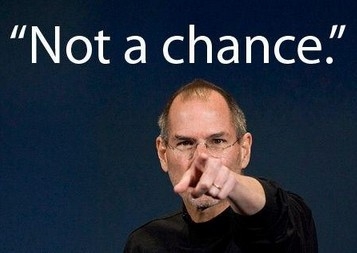Even worse, the perfection of the cube made it hard to manufacture. Most parts that are cast in molds have angles that are slightly greater than pure 90 degrees, so that it’s easier to get them out of the mold (just as it is easier to get a cake out of a pan that has angles slightly greater than 90 degrees). But Esslinger dictated, and Jobs enthusiastically agreed, that there would be no such “draft angles” that would ruin the purity and perfection of the cube. So the sides had to be produced separately, using molds that cost $650,000, at a specialty machine shop in Chicago. Jobs’s passion for perfection was out of control. When he noticed a tiny line in the chassis caused by the molds, something that any other computer maker would accept as unavoidable, he flew to Chicago and convinced the die caster to start over and do it perfectly. “Not a lot of die casters expect a celebrity to fly in,” noted one of the engineers. Jobs also had the company buy a $150,000 sanding machine to remove all lines where the mold faces met and insisted that the magnesium case be a matte black, which made it more susceptible to showing blemishes.
更糟的是,完美的立方體生產起來也很困難。大部分模具鑄造出來的零件都不是純直角,而是會稍微超過90度,因為這樣會比較容易把零件從模具中拿出來。(就像平底鍋鍋沿的角度稍微超過90度,煎餅會比較容易拿出來一樣。)但是,艾斯林格下令,不能有這種拔模角度,不能破壞立方體的純粹和完美。喬布斯對此表示狂熱支持。因此,每一面都必須分開制作,使用價格65萬美元的模具,在芝加哥的一家專業機器加工廠制作。喬布斯對于完美的熱情已然失控。當他注意到模具在機箱底盤上留下的微小細紋時,他就會飛到芝加哥,說服鑄模工人重鑄,直到完美。而這種微小瑕疵是其他任何計算機制造商都能接受的。“大部分鑄模工人都想不到會有名人專程飛來找自己。”NeXT項目的一位工程師戴維·凱利(DavidKelley)指出。喬布斯還讓這家公司購買了一臺價值15萬美元的砂光機,用來去除模具面相交處的所有細紋。喬布斯堅持鎂合金外殼應該是亞光黑色,而這樣,如果有瑕疵就會更明顯。
Jobs had always indulged his obsession that the unseen parts of a product should be crafted as beautifully as its fa?ade, just as his father had taught him when they were building a fence. This too he took to extremes when he found himself unfettered at NeXT. He made sure that the screws inside the machine had expensive plating. He even insisted that the matte black finish be coated onto the inside of the cube’s case, even though only repairmen would see it.
喬布斯一直認為,產品看不見的地方也應該和露在外面的部分一樣精美,就像他的父親會用一塊上好木材做衣柜的背面一樣。當他發現自己在NeXT可以不受約束時,就任由自己在這方面走向極端。喬布斯要求機器內部的螺絲一定要有昂貴的鍍層,甚至堅持把立方體的內部也涂成亞光黑色,即便只有維修人員才能看得到。
Joe Nocera, then writing for Esquire, captured Jobs’s intensity at a NeXT staff meeting:
喬·諾切拉(JoeNocera)當時為《君子》雜志寫稿,記述了喬布斯在NeXT員工會議上前強烈表現:
It’s not quite right to say that he is sitting through this staff meeting, because Jobs doesn’t sit through much of anything; one of the ways he dominates is through sheer movement. One moment he’s kneeling in his chair; the next minute he’s slouching in it; the next he has leaped out of his chair entirely and is scribbling on the blackboard directly behind him. He is full of mannerisms. He bites his nails. He stares with unnerving earnestness at whoever is speaking. His hands, which are slightly and inexplicably yellow, are in constant motion.
如果說他坐著開完了員工會議,就不太準確,因為喬布斯從來沒有耐著性子坐到會議結束。他控制局面的途徑之一就是不斷地動來動去。這一刻他還跪在自己的椅子上,下一分鐘就懶散地窩在椅子里,過了一會兒又干脆跳出椅子,開始在身后的黑板上亂涂亂畫。他有很多怪癖,包括咬指甲,還有用他那令人膽怯的認真勁兒盯著說話的人。他的手有些莫名的發黃,不斷在動。
<span style=\"color:#006400\\"\">What particularly struck Nocera was Jobs’s “almost willful lack of tact.” It was more than just an inability to hide his opinions when others said something he thought dumb; it was a conscious readiness, even a perverse eagerness, to put people down, humiliate them, show he was smarter. When Dan’l Lewin handed out an organization chart, for example, Jobs rolled his eyes. “These charts are bullshit,” he interjected. Yet his moods still swung wildly, as at Apple. A finance person came into the meeting and Jobs lavished praise on him for a “really, really great job on this”; the previous day Jobs had told him, “This deal is crap.”
最讓諾切拉震驚的是喬布斯的“幾乎故意的人際交往技巧缺乏”。當別人說出喬布斯認為愚蠢的意見時,他似乎早有準備,急迫地想要貶低、羞辱他人,以顯示自己更聰明。例如,當丹·盧因拿出一份組織結構圖時,喬布斯轉了轉眼珠。“這些東西狗屁不是。”他最終插話道。不過,他的情緒仍然喜怒無常,就像在蘋果公司時一樣,一會兒把人捧成英雄,過一會兒又把人貶成混蛋。一位財務人員來到會議室,喬布斯慷慨地稱贊他“在這個項目上的工作非常非常出色”;但是前一天,喬布斯才對他說過:“這筆交易跟垃圾沒什么兩樣。”
One of NeXT’s first ten employees was an interior designer for the company’s first headquarters, in Palo Alto. Even though Jobs had leased a building that was new and nicely designed, he had it completely gutted and rebuilt. Walls were replaced by glass, the carpets were replaced by light hardwood flooring. The process was repeated when NeXT moved to a bigger space in Redwood City in 1989. Even though the building was brand-new, Jobs insisted that the elevators be moved so that the entrance lobby would be more dramatic. As a centerpiece, Jobs commissioned I. M. Pei to design a grand staircase that seemed to float in the air. The contractor said it couldn’t be built. Jobs said it could, and it was. Years later Jobs would make such staircases a feature at Apple’s signature stores.
NeXT最初的十名員工中,就有一位是室內設計師,負責帕洛奧圖總部的設計,這是NeXT公司的第一個總部。雖然喬布斯租下的大樓是新建的,設計也漂亮,但他將內部設施全部拆毀重建。墻壁換成了玻璃,地毯換成了淺色的硬木地板。1989年,NeXT公司搬到雷德伍德一個更大的地方時,這一過程再次上演。盡管大樓是全新的,但是喬布斯堅持要將電梯挪走,讓大堂顯得更為恢弘。在大堂的中心,喬布斯委托貝聿銘設計了一段宏偉的樓梯,看上去就像飄浮在空中一樣。承建商表示這個設計沒法實現,喬布斯堅持能夠做到,最終也確實建成了。多年后,喬布斯把這款樓梯變成了蘋果專賣店的特色。











